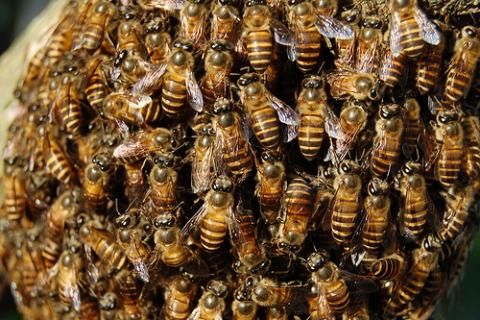
Photo of swarming bees by Flickr user Francis Chung. Published under Creative Commons license.
Hats off to Daily Mail reporter Hilary Hawke, who had a ripping yarn in last Wednesday's paper about a swarm of more than 10,000 bees that moved into the walls of a second-floor apartment in Ravena: "Bees invade Westerlo Street home."
Hawke paints the scene in Technicolor:
Imagine sitting on your porch on one of the first warm days of spring after a brutal and prolonged winter, ready to kick back and enjoy the weather when suddenly an insistent buzzing like the sound of dozens of weedwackers shatters the quiet.
Thousands of tiny dark objects appear overhead, speckling the sky like bits of dirt hovering mid-air.
A huge writhing furry mass hangs suspended in a nearby tree.
Kids walking down the street stop, terrified to pass by the furious winged assailants.
"That's crazy mad," says one teen, halting at the corner of Colvin and Westerlo, afraid to venture any closer. "I've never seen anything like that in my life."
The story has a happy ending: after a couple of weeks, the bees were finally captured by Fulton County beekeeper Dan Kerwood, with a shop-vac, saws, and a few five-gallon buckets.
Though honeybee swarms are alarming, they're a natural phenomenon. When a hive's population is large enough for the colony to split into two -- usually in the late spring or early summer -- the old queen lays a few queen eggs in the old hive, and then takes off with a retinue of workers to find a new home before her royal daughters hatch.
Beekeepers are often glad to scoop up a swarm and use it to start a new hive. Like the old nursery rhyme says, the earlier you catch a swarm, the less you'll have to feed it to get it established:
- A swarm of bees in May
- Is worth a load of hay;
- A swarm of bees in June
- Is worth a silver spoon;
- A swarm of bees in July
Is not worth a fly.










